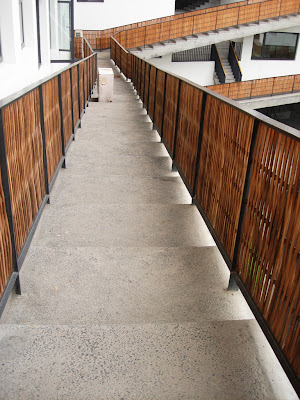標籤:
倉海君,
普通讀者
偶於網上發現心經各種譯本,分別是拉丁文、英文和德文:
般若波罗蜜多心经
观自在菩萨,行深般若波罗蜜多时,照见五蕴皆空,度一切苦厄。舍利子,色不异空,空不异色;色即是空,空即是色。受想行识,亦复如是。舍利子,是诸法空相, 不生不灭,不垢不净,不增不减。是故空中无色,无受想行识,无眼耳鼻舌身意,无色声香味触法,无眼界,乃至无意识界,无无明,亦无无明尽。乃至无老死,亦 无老死尽。无苦集灭道,无智亦无得,以无所得故。菩提萨陲,依般若波罗蜜多故,心无挂碍,无挂碍故,无有恐怖,远离颠倒梦想,究竟涅盘。三世诸佛,依般若 波罗蜜多故,得阿耨多罗三藐三菩提。故知般若波罗蜜多,是大神咒,是大明咒,是无上咒,是无等等咒,能除一切苦,真实不虚。故说般若波罗蜜多咒,即说咒 曰:揭谛揭谛,波罗揭谛,波罗僧揭谛,菩提娑婆诃。
Sutra Cordis Magnae Sapientiae Transcendentis
Bodhisattva Avalokita,profundam Sapientiam transcendentem excolens,quinque complexuum vacuam naturam conspexit,et hoc modo omnes dolores superavit.- Shariputra, forma dissimilis non est vacuitatis,vacuitas dissimilis formae non est.Forma est vacuitas, vacuitas forma est.Idem accidit sensibus, perceptionibus, propensionibus, conscientiis.- Shariputra, omnia phaenomena natura vacua sunt:non nata neque exstincta, non pura neque impura,non crescentia neque decrescentia.Ideo in vacuitateforma, sensus, perceptio, propensio, conscientia non est;non oculus, auris, nasus, lingua, corpus, mens;non species, sonus, odor, sapor, contactus, notio.Sensus videndi non est, neque alia elementa huius generisusque ad mentis conscientiam.Ignorantia non est, neque finis eius, aliaque huius generisusque ad senectutem et mortem, neque finis eorum est.Labor non est, non causa, non exitus, non Via.Scientia non est, neque adeptio.Cum nihil adipiscendum sitbodhisattva Sapientia transcendente nisus,animo libero ab impedimentis vivit.Impedimentis non obstantibus nulla timet,falsas cogitationes relinquit et summum Nirvana fit.Cum Sapientia transcendente nitantur, omnes Buddha trium temporumperfectam Illuminationem consequuntur.Scito igitur Sapientiam transcendentemsublimem mantra esse, mantra magnum et fulgentem,maximum mantra, mantra sine aequali,quod omnes labores dissolvere potest.Verum est, sine errore.Proinde mantra Sapientiae transcendentis ita pronuntia:GATE GATE PARAGATE PARASAMGATE BODHI SVAHA!(Ivit, ivit, transivit, totum transivit, Illuminatio tum sit!)
THE HEART OF PRAJNA PARAMITA SUTRA
When Bodhisattva Avalokiteshvara was practicing the profound Prajna Paramita, he illuminated the Five Skandhas and saw that they are all empty, and he crossed beyond all suffering and difficulty.Shariputra, form. does not differ from emptiness; emptiness does not differ from form. Form. itself is emptiness; emptiness itself is form. So too are feeling, cognition, formation, and consciousness.Shariputra, all Dharmas are empty of characteristics. They are not produced, not destroyed, not defiled, not pure; and they neither increase nor diminish. Therefore, in emptiness there is no form, feeling, cognition, formation, or consciousness; no eyes, ears, nose, tongue, body, or mind; no sights, sounds, smells, tastes, objects of touch, or Dharmas; no field of the eyes up to and including no field of mind consciousness; and no ignorance or ending of ignorance, up to and including no old age and death or ending of old age and death. There is no suffering, no accumulating, no extinction, and no Way, and no understanding and no attaining.Because nothing is attained, the Bodhisattva through reliance on Prajna Paramita is unimpeded in his mind. Because there is no impediment, he is not afraid, and he leaves distorted dream-thinking far behind. Ultimately Nirvana! All Buddhas of the three periods of time attain Anuttara-samyak-sambodhi through reliance on Prajna Paramita. Therefore know that Prajna Paramita is a Great Spiritual Mantra, a Great Bright Mantra, a Supreme Mantra, an Unequalled Mantra. It can remove all suffering; it is genuine and not false. That is why the Mantra of Prajna Paramita was spoken. Recite it like this:Gaté Gaté Paragaté Parasamgaté Bodhi Svaha!
Das Herz-Sutra der Grossen Weisheit
Der Bodhisattva Avelokiteshvara, der tief in Prajnaparamita versunken ist, sieht deutlich, daß die fünf Skandhas ihrem Wesen nach leer sind, und überwindet dadurch alles Leiden (...und hilft dadurch allen Wesen). Oh Shariputra, Form ist Leere, Leere ist Form, Form ist nicht anders als Leere, Leere ist nicht anders als Form. Das, was Form ist, ist Leere, das was Leere ist, ist Form. Sinneswahrnehmungen, Gedanken, Vorstellungen und Bewußtsein sind ebenfalls leer. Shariputra, alle Dinge sind durch Leere charakterisiert. Sie werden nicht erzeugt, sie werden nicht vernichtet. Sie sind nicht unrein, sie sind nicht rein. Sie wachsen nicht, sie nehmen nicht ab. Deshalb gibt es in der Leere keine Form, keine Sinneswahrnehmung, keine Gedanken, keine Vorstellungen, kein Bewußtsein. Kein Auge, kein Ohr, keine Nase, keine Zunge, keinen Körper, keinen Geist. Es gibt keine Farbe, kein Geräusch, keinen Geruch, keinen Geschmack, keine Empfindung, keine Gedankeninhalte. Es gibt keine Bereiche des Sehens, Hörens, Riechens, Schmeckens und Tastens sowie keine Welt des Bewußtseins. In der Leere gibt es kein Wissen, kein Nichtwissen und so fort. Es gibt kein Alter und Tod sowie kein Auslöschen von Alter und Tod. Es gibt kein Leiden, keinen Ursprung von Leiden, keine Vernichtung von Leiden, keinen Weg zur Vernichtung von Leiden. In der Leere gibt es keine Erkenntnis und kein Erreichen, da es nichts zu erreichen gibt. Im Geiste des Bodhisattva, der in Prajnaparamita verweilt, gibt es keine Hindernisse, und da er frei von Hindernissen ist, hat er keine Angst. Indem er die falschen Ansichten überwindet, kennt er das letzte Nirvana. Alle Buddhas der Vergangenheit, Gegenwart und Zukunft stützen sich auf Prajnaparamita und gelangen dadurch zur höchsten vollkommenen Erleuchtung. Deshalb muß man wissen, daß das Prajnaparamita Sutra das große universale Sutra ist, das Sutra der großen Weisheit, das höchste aller Sutras, das Sutra ohne seinesgleichen. Es hat die Fähigkeit, alle Schmerzen zu lindern. Seine Wahrheit ist frei von Irrtum. Das Mantra, das im Prajnaparamita verkündet wird, lautet: "Gate, gate paragate parasamgate bodhi svaha!"(Hinüber, hinüber, zum anderen Ufer hinüber gegangen, am anderen Ufer angekommen. Höchste Weisheit, Svaha).
一直沒考究最後的咒語何義,現在看到拉丁文和德文版才發現這麼有意思。拉丁文譯本完全模仿了梵文中層層遞進的結構:
GATE GATE PARAGATE PARASAMGATE BODHI SVAHA!
Ivit, ivit, transivit, totum transivit, Illuminatio tum sit!
(過了,過了,已經越過了,一切都已越過了,就讓你覺悟吧!)
德文本則多了anderen Ufer(彼岸)這意象,我認為是敗筆:佛陀一覺醒來,萬象歸空,何必再分彼此?哪有彼岸可到?咒語宜虛不宜實,才能讓心靈默觀到那種seen in the unseen的真光。梵文原義已查證過,拉丁文基本上是照字面直譯。原文"para-"這個prefix就是譯文的"trans-",「彼岸」是德譯加上去的,「抵達」(angekommen)更是原文所無的意思--德譯實在太花心思了。
然而咒語應不應翻譯呢?我認為原文可解就譯,不可解就不譯。而梵文咒語本身是可解的,且簡潔有力,只要準確保存到原來的意思、節奏和結構,為什麼不譯?(但如果像德譯那樣,還是不譯較好)大家可留意:心經咒語有一特點,就是不容許任何形象思維(是為「虛」)。「什麼」過了?越過「什麼」?都是刻意略過不提 的,目的就是要你觀空,這跟西方中世紀的God-talk有異曲同工之妙:例如Anselm定義上帝為「那沒法設想比之更偉大的東西」(aliquid quo nihil maius cogitari possit),就是要你無法把神形象化,以助玄想登天。至於玄奘為何不譯出來呢?我不知道。可能他也認為咒不可譯,或者是古漢語不能準確翻譯(咒絕對不能偏差)。試問prefix你如何譯?我試試用文言來翻,大約是:
既往,既往,超然既往,一切超然既往,是證菩提。
後來跟朋友B奇文共賞,辨析疑義,B則說:
「即便不說原文文義,單單形式、結構已不相稱。嚴格來講,不是翻譯而是譯者註釋。玄奘不譯,我猜度是因為咒不可譯。咒語的音的重要性,比之其意,應不遑多讓。還有,那個prefix很難譯,『超然』?似乎拗口些。嘗試來一個這樣的,『已矣,已矣,俱已矣,一切俱已矣。得證菩提。』回避了prefix的難題,但不完整。依此,德文試直譯如下:
Hinüber, hinüber, quer hinüber, völlig quer hinüber. Höchste Weisheit,Svaha.」
修辭本身就是magic,咒語之所以不宜譯,也許正因為它根本就是詩。

























